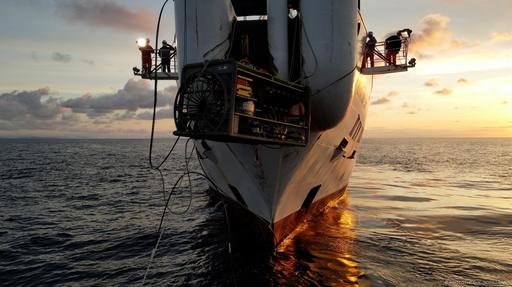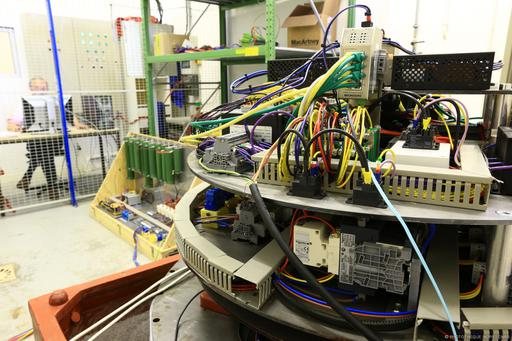Laboratoire Sous-marin Provence Méditerranée
The Laboratoire Sous-marin Provence Méditerranée (LSPM) is a national plateform of CNRS's National Institute of Nuclear and Particle Physics (LSPM, CNRS UAR2032 unit). LSPM has been labelled "Aix-Marseille Plateform" in order to structure the offer of skills and to make it easily accessible to the socio-economic and academic world. Aix-Marseille University and Ifremer participate in the piloting of this infrastructure oriented towards multidisciplinary research and scientific culture. CPPM is the host laboratory for this platform, consisting essentially of an underwater infrastructure, installed at a depth of 2,450 meters, 40 kilometers south of Toulon, with real-time data transmission from the various instruments to the control rooms on land (La Seyne-sur-Mer, Marseille). The LSPM platform hosts the KM3NeT ORCA neutrino detector and EMSO environmental sensors. Other underwater connection links are available for new users.
Underwater infrastructure:
-
electro-optical cables for shore connection,
-
junction boxes for interfacing underwater instrumentation,
-
long base acoustic positioning system,
-
junction box dedicated to environmental measures.
Land infrastructure with a multidisciplinary and educational vocation:
-
Main control room in La Seyne-sur-Mer: real-time control of experiments, data acquisition and processing, high-speed connection to other control and storage centers,
-
Remote control room at the CPPM: showroom, reception, multimedia installations.
The plateform was initiated through the MEUST/NUMerEnv subsea insfrastructure (MEUST), and hosts the French site of the international KM3NeT experiment. It also represents the West-Ligure node of EMSO for environmental studies conducted by the Technical Division of the National Institute of Sciences of the Universe (DT-INSU) of the CNRS, the Mediterranean Institute of Oceanology (MIO), the Computer and Systems Laboratory (LIS) and Géoazur. LSPM is the second generation of submarine infrastructure, after the one deployed in the framework of the ANTARES experiment.
The LSPM is financed through the NEUMED project within the framework of the State-Region Plan Contract (CPER) by the Délégation Régionale Académique à la Recherche et à l'Innovation (DRARI), the Région Sud, the CNRS through the Institut National de Physique Nucléaire et de Physique des Particules (IN2P3) (National Institute for Nuclear Physics and Particle Physics), the Conseil départemental des Bouches-du-Rhône, the Metropole d'Aix-Marseille Provence, and the City of Marseille.
The LSPM was also able to take form with the previous projects MEUST and NUMerEnv thanks to financial contributions from the European Union (FEDER), France: Ministry (DRARI), CNRS, Aix-Marseille University, South Region, Var Departmental Council, Toulon Provence Mediterranean Metropolis, City of Marseille. The LSPM is supported by the City of La Seyne-sur-Mer as the host city for the control room and the power station. It also benefits from the support of the Pôle Méditerranée, the University of Toulon and the many skills of the industrial fabric of the Provence-Alpes-Côte d'Azur region in the marine field.
Contact: lspm@in2p3.fr
What’s the underwater laboratory LSPM? By the Operational Manager LSPM at the CPPM | Production CPPM 2023
Management:
- Manager of the platform: Paschal Coyle (CPPM)
- Operational Manager: Pascale Keller (CPPM)
- Technical Manager: Stéphane Théraube (CPPM)
Mission Managers:
- Communication: Magali Damoiseaux (CPPM)
- Data: Jürgen Brunner (CPPM)
- Quality: Laurence Caillat (CPPM)
Steering Committee:
- Astroparticle Scientific Assistant Director of IN2P3: Vincent Poireau
- Interdisciplinary Scientific Assistant Director of IN2P3: Sébastien Incerti
- Technical Assistant Director of IN2P3: Rémi Cornat
- Associate Vice-President Science - Technology: Stéphane Viel
- Mediterranean Ifremer Director: Vincent Rigaud
- CPPM Director: Cristinel Diaconu
- CPPM Technical Director: Thierry Mouthuy
- CPPM Astroparticle Team leader: Vincent Bertin
- LSPM Management
- LSPM Mission Managers
ComEx Experiences/Users Committee:
- LSPM Management
- LSPM Mission Managers
- Ifremer Representative
- KM3NeT Representative
- EMSO Representative
External Scientific Committim progress:
- Rosa Coniglione, KM3NeT Management
- Giacomo Cuttone, IDMAR/Sicile
- Frédéric Mosca, Exail (IxBlue) Company
- Benoit Pirenne, Oceans Networks Canada
- Christophe Rabouille, LSCE (Laboratoire des Sciences du Climat et de l'Environnement)
• Probing invisible neutrino decay with the first six detection units of KM3NeT/ORCA, S. Aiello et al., KM3NeT Collaboration, JHEP 04 (2025), 105
• Search for quantum decoherence in neutrino oscillations with six detection units of KM3NeT/ORCA S. Aiello et al., KM3NeT Collaboration, JCAP 03 (2025), 039
• Search for non-standard neutrino interactions with the first six detection units of KM3NeT/ORCA S. Aiello et al., KM3NeT Collaboration, JCAP 02 (2025), 073
• Measurement of neutrino oscillation parameters with the first six detection units of KM3NeT/ORCA, S. Aiello et al., KM3NeT Collaboration, JHEP 10 (2024), 206
• Search for neutrino emission from GRB 221009A using the KM3NeT ARCA and ORCA detectors, S. Aiello et al., KM3NeT Collaboration, JCAP 08 (2024), 006
• Searches for neutrino counterparts of gravitational waves from the LIGO/Virgo third observing run with KM3NeT, S. Aiello et al., KM3NeT Collaboration, J. Cosmol. Astropart. P 04 (2024) 026
• Un télescope sous-marin traque l'infiniment petit, in Océan, la mer est notre avenir, hors-série Ouest France, numéro 3, 21 mars 2024, par Laurie Musset
• Neutrino mass ordering determination through combined analysis with JUNO and KM3NeT/ORCA, João Pedro Athayde Marcondes de André et al., KM3NeT and JUNO Collaborations, Nucl. Instrum. Meth.A 1055 (2023), 168438
• Probing invisible neutrino decay with KM3NeT/ORCA, S. Aiello et al., KM3NeT Collaboration, JHEP 04 (2023), 090
• First observation of the cosmic ray shadow of the Moon and the Sun with KM3NeT/ORCA, S. Aiello et al., KM3NeT Collaboration, Eur. Phys. J.C 83 (2023) 4, 344
• High resolution seafloor thermometry for wave and upwelling monitoring using Distributed Acoustic Sensing, J. D. Pelaez Quiñones et al., Sci. Rep 13 (2023) 17459
• Determining the neutrino mass ordering and oscillation parameters with KM3NeT/ORCA, S. Aiello et al., KM3NeT Collaboration, Eur. Phys. J.C 82 (2022) 1, 26, Eur.Phys.J.C 82 (2022), 26
• Implementation and first results of the KM3NeT real-time core-collapse supernova neutrino search, S. Aiello et al., KM3NeT Collaboration, Eur. Phys. J. C 82 (2022) 317
• Combined sensitivity of JUNO and KM3NeT/ORCA to the neutrino mass ordering, S. Aiello et al., KM3NeT and JUNO Collaborations, JHEP 03 (2022), 055
• Sensitivity to light sterile neutrino mixing parameters with KM3NeT/ORCA, S. Aiello et al., KM3NeT Collaboration, JHEP 10 (2021), 180
• On the Detection Capabilities of Underwater DAS, I. Lior et al., JGR Solid Earth 126 (2021) e2020JB020925
• Event reconstruction for KM3NeT/ORCA using convolutional neural networks, S. Aiello et al., KM3NeT Collaboration, JINST 15 (2020) 10, P10005
• Les abysses cachent un monde de lumière, in Pop'sciences Mag, numéro 6, juin 2020, par Caroline Depecker
• Première publication des données KM3NeT : Dependence of atmospheric muon rate on seawater depth measured with the first KM3NeT detection units, M. Ageron et al. , KM3NeT Collaboration, Eur. Phys. J. C (2020) 80-99
• Distributed sensing of earthquakes and ocean-solid Earth interactions on seafloor telecom cables, A. Sladen et al. , Nat. Commun. 10 (2019) 5777
• Unique observatories for sea science and particle astrophysics: The EMSO-Antares and EMSO-Western Ionian nodes in the Mediterranean Sea, Dominique Lefevre, Bruno Zakardkjian, Daniele Embarcio, EPJ Web of Conferences 207, 09004 (2019), https://doi.org/10.1051/epjconf/201920709004
• KM3NeT 2.0 – Letter of Intent for ARCA and ORCA KM3NeT Collaboration: S. Adrián-Martínez et al. J. Phys. G: Nucl. Part. Phys. 43 (2016) 084001
LSPM Highlights:
-
January 2024: relocation of the control station to the Brégaillon site, housed at Ifremer, until the MEUST building is ready.
-
November 2023 : Laying of the first stone of the MEUST building, 10th november.
-
September 2023 : Exhibition "Des abysses au cosmos", 15th september - 8th october, fort Napoléon, La Seyne-sur-Mer.
-
May 2023: Bathybot a robot awakens in the depths of the Mediterranean.
-
April 2023: Deployment of an interface junction box (pre-BJS) to connect the science junction box (BJS) to the LSPM cable network. Connection of its new submarine scientific instruments.
-
February 2023: Inauguration of LSPM
-
July 2022: Creation of a support and research unit, UAR2032, entitled Laboratoire Sous-marin Provence Méditerranée
-
February 2022: Deployment of Ifremer's scientific junction box with its instruments (gamma spectrometer (CPPM), seismometer (Géoazur), BioCamera (IP2I), BathyBot (MIO, DT INSU))
-
October 2021: Labelling as an Aix-Marseille (AMU) technology platform
-
June 2021: Installation of the control room on the Aix-Marseille University campus - Luminy site
-
May 2021: Second steering committee of the LSPM
-
October 2020: Deployment and connection of the Second Junction Box of the LSPM submarine infrastructure
-
June 2020: First meeting of the LSPM steering committee
-
March 2020: Fundation of the national plateform CNRS/IN2P3 called Laboratoire sous-marin Provence Méditerranée (LSPM)
-
June 2019: CNRS Collective Crystal price has been awarded to the technical team of CPPM for the development and builing of the submarine MEUST/NUMenEnv infratructure
-
Octobre 2018: Commissioning of the submarine infrastructure MEUST/NUMerEnv with the first junction box
Scientific Experiments Highlights:
-
April 2023: Installation of 3 new detection lines on the KM3NeT/ORCA site. This detector is now composed of 18 lines in continuous data taking.
-
December 2022: The Prize for Research 2022 of the Bouches-du-Rhône Department was awarded to the astroparticle neutrino team.
-
March 2021: Publication of the sensitivity on the determination of the neutrino mass ordering and measurements of oscillation parameters with KM3NeT/ORCA, which CPPM is main author
-
February 2021: Paschal Coyle, physicist at CPPM, is nominated Spokesman of the KM3NeT Collaboration for 2 years
-
February 2021: Publication of the sensitivity on the detection of core-collapse supernovae neutrinos with KM3NeT, which CPPM is main author
-
March 2020: KM3NeT contribues now to the SNEWS alert network for SNovea detection
-
January 2020: Installation of two new detection lines of the KM3NeT/ORCA detector which actually takes data continuously with 6 detection lines
-
Novembre 2019: First real time follow-up of a multi-messenger alert (gravitational wave S191110af) with KM3NeT and publication of its first notice(GCN #26249)
-
July 2019: Installation of two new detection lines of the KM3NeT/ORCA detector which actually takes data continuously with 4 detection lines
-
June 2019: Publication of the first KM3NeT analysis article - Dependence of atmospheric muon flux on seawater depth measured with the first KM3NeT detection units - with a major CPPM contribution
-
May 2019: Publication by the "Le MONDE" newspaper of the CNRS Image Video « Pêcheurs de neutrinos » on the building of KM3NeT/ORCA
-
May 2019: Installation of a new detection line of the KM3NeT/ORCA detector which now takes data with 2 detection lines, installation of the oceanographic module MII
-
February 2019: Installation of the first line of the K3NeT/ORCA detector
-
January 2019: Publication of the Letter of Intent on the Protvino-to-ORCA (P2O) project using a neutrino beam to measure the CP violation in the neutrino sector
- Availability of deep user ports, with electro-optical link to ground, for instrumentation connection
Connection on onnection Node (N1, N2, ...):
-
Power: 400 Vrms (AC), 1 kVA
-
Optical Communication: 2 FO
-
Connector: Teledyne ODI NRH APC, flying ROV Titanium connector
Connection on BJS:
-
Power: 300 Vdc, 1 kW
-
Ethernet Communication: 1 link 100 base T
-
Connector: Teledyne ODI, flying ROV Titanium connector, type ROV[1]161-01-12-4
- Availability of the acoustic positioning system
- Installation of "passive" systems for long-term ageing tests (materials, etc.)



















